Research Findings on the Application of the Arch Structure Model in Coal Mining, a Review
Abstract
:1. Introduction
2. Formation of the Arch Structure Model Hypothesis
3. Construction of Arch Structure Model
3.1. Model of Unconsolidated Layer Arch Model
3.2. Arch Structure Model of Overlying Rock
- (1)
- Linear arch (beam arch)
- (2)
- Overburden arch (stress arch, fracture arch)
4. Research Findings and Its Application of Unconsolidated Layer Arch Model
4.1. Research Findings of Unconsolidated Layer Arch
- (1)
- Theoretical model
- (2)
- Numerical and similarity simulation
- (3)
- Field measurement verification
4.2. Application of the Unconsolidated Layer Arch
5. Research Findings on the Application of the Overburden Arch Model
5.1. Research Findings of Overburden Arch Model
- (1)
- Theoretical model
- ①
- Before the construction of the stress arch model, the arch track shape is assumed, such as semi-circle, semi-ellipse, and parabola shape, and then the stress arch model under the assumed track shape is produced, and the stress load analysis under the relevant state is carried out.
- ②
- Although the overburden of a coal mine has obvious bedding characteristics, the strengths of the rock strata are also obviously different. The overburden is assumed to be homogeneous in the construction of the stress arch model, which is basically consistent with the modeling of the unconsolidated layer arch. However, the actual rock strata are inhomogeneous layered rock masses, including hard and soft rock strata. In addition to the large difference in the lithology of each layer, there are obvious weak planes between layers. To solve this problem, Lu et al. [67] proposed the recursive method of the fractured arch, that is, the equation of the fractured arch of the lower strata was solved first, and the equation of the upper layer was established on the basis of the solution of the next layer. This actually reverts to the calculation of the fracture arch of a single rock stratum, and extends the beam arch model to the stress arch model.
- ③
- In the process of setting the boundary stress of the overburden arch, uniform load is generally applied above the arch, and the size is proportional to the buried depth, which is consistent with the boundary conditions of the unconsolidated layer arch (Figure 5). Considering the large depth span of the overburden stress arch, the loads on the left and right sides of the arch are developed from the initial uniform load to the trapezoidal load considering the buried depth. The magnitude is the vertical stress multiplied by the lateral pressure coefficient at its location. From the setting of stress boundary, it can be seen that the stress inside the arch is not taken into account in the process of constructing the arch structure model. However, there is rock mass support under both the stress arch and the fracture arch. Therefore, the current theoretical model of the overburden arch is more inclined to caving due to the stress boundary conditions.
- ④
- The construction of the stress arch model is mainly to obtain the trace equation of the arch. The main parameters involved in the arch construction process include coal seam burial depth (H), arch height (h), arch span (2a0), overburden firmness coefficient f (or overburden cohesion, internal friction angle), lateral pressure coefficient λ, and bulk density γ; the trace equation of arch can be expressed as Equation (2).where q0 = γ(H − h); q1 = λγ(H − h); q2 = λγH. The trace equation of “stress arch” can be obtained by replacing x and z in Equation (2) with span and arch height. After the trace equation of the arch is obtained, the bearing state of the arch can be further deduced, and the conditions for forming and breaking the arch can be judged.
- ⑤
- There is no method to determine the arch thickness of overburden stress. The unconsolidated layer arch model proposed by Wang et al. [37] provides the calculation equation of arch thickness, which is mainly determined according to the range of abutment pressure in advance of the arch foot, and assumes that the thickness of the arch and the arch foot is the same. However, this is not applicable to the model of the heterogeneous overburden arch, and the thickness of arch obtained by numerical simulation is not consistent.
- (2)
- Numerical simulation and similarity simulation
- (3)
- Field measurement verification
5.2. Overburden Arch Structure Model Application
6. Prospects for the Study of the Arch Structure Model
7. Conclusions
Funding
Institutional Review Board Statement
Informed Consent Statement
Data Availability Statement
Conflicts of Interest
References
- Chen, C.; Hu, Z. Research advances in formation mechanism of ground crack due to coal mining subsidence in China. J. China Coal Soc. 2018, 43, 810–823. [Google Scholar]
- Wang, J.; Yang, S.; Wei, W.; Zhang, J.; Song, Z. Drawing mechanisms for top coal in longwall top coal caving (LTCC): A review of two decades of literature. Int. J. Coal. Sci. Technol. 2021, 8, 1171–1196. [Google Scholar] [CrossRef]
- Gao, R.; Kuang, T.; Zhang, Y.; Zhang, W.; Quan, C. Controlling mine pressure by subjecting high-level hard rock strata to ground fracturing. Int. J. Coal. Sci. Technol. 2021, 8, 1336–1350. [Google Scholar] [CrossRef]
- Miao, X.; Qian, M. Advance in the key strata theory of mining rockmass. J. China Univ. Min. Technol. 2000, 29, 25–29. [Google Scholar]
- Qian, M. Theory and Practice of Surrounding Rock Control in Stope. Ground Press. Strat. Control 1999, Z1, 12–15. [Google Scholar]
- Qian, M.; Miao, X.; Xu, J. Theoretical study of key stratum in ground control. J. China Coal Soc. 1996, 3, 2–7. [Google Scholar]
- Song, Z.; Hao, J.; Shi, Y.; Tang, J.; Liu, J. An overview of connotation and development of practical ground pressure control theory. J. Shandong Univ. Sci. Technol. 2019, 38, 1–15. [Google Scholar]
- Li, C.; Zhang, Y.; Zuo, J.; Tang, S.J.; Liu, S.F. Floor failure mechanical behavior and partition characteristics under the disturbance of voussoir beam instability in deep coal mining. J. China Coal Soc. 2019, 44, 1508–1520. [Google Scholar]
- Xu, J. Strata control and scientific coal mining—a celebration of the academic thoughts and achievements of Academician Minggao Qian. J. Min. Saf. Eng. 2019, 44, 1508–1520. [Google Scholar]
- Qian, M.; Xu, J. Behaviors of strata movement in coal mining. J. China Coal Soc. 2019, 38, 1–15. [Google Scholar]
- Zou, X. A new interpretation of the pressure arch hypothesis. Mine Press. 1989, 1, 67–68. [Google Scholar]
- Zhang, J.; Li, J.; An, T.; Huang, Y. Deformation characteristic of key stratum overburden by raw waste backfilling with fully-mechanized coal minning technology. J. China Coal Soc. 2010, 35, 357–362. [Google Scholar]
- Yu, Q.; Zhang, H.; Deng, W.; Zou, Y. Analysis of influencing factors of surface skewed subsidence based on key strata theory. J. China Coal Soc. 2018, 43, 1322–1327. [Google Scholar]
- Jiang, F.; Wen, J.; Bai, W.; Wang, G.; Li, M. Rock burst risk in surrounding abscission layer of overlying high key strata in deep strip mining mines. J. China Univ. Min. Technol. 2018, 47, 40–47. [Google Scholar]
- Wang, H.; Fan, X.; Jia, J.; Hu, G.; Yuan, Z. Effects of key strata on protection when exploiting a steep-incline underlying a protecting stratum. J. China Univ. Min. Technol. 2011, 40, 23–28. [Google Scholar]
- Lu, H.; Meng, X.; Zhang, Y.; Yao, D. Mechanical analysis of water barrier performance of floor layered structure key stratum on coal face. J. China Univ. Min. Technol. 2020, 49, 1057–1066. [Google Scholar]
- Zhu, W.; Xu, J.; Lai, W.; Wang, Z. Research of isolated section-grouting technology for overburden bed separation space to reduce subsidence. J. China Coal Soc. 2007, 32, 458–462. [Google Scholar]
- Song, Z. Development status of mining engineering discipline in China and discussion on issues of its further development. Hazard Control. Tunn. Undergr. Eng. 2019, 1, 7–12. [Google Scholar]
- Yang, W.; Lin, B.Q.; Yan, Q.; Zhai, C. Stress redistribution of longwall mining stope and gas control of multi-layer coal seams. Int. J. Rock Mech. Min. Sci. 2014, 72, 8–15. [Google Scholar] [CrossRef]
- Zhang, C.; Bai, Q.; Chen, Y. Using stress path-dependent permeability law to evaluate permeability enhancement and coalbed methane flow in protected coal seam: A case study. Geomech. Geophys. Geo-Energy Geo-Resour. 2020, 6, 1–25. [Google Scholar] [CrossRef]
- Johann, W.R. Die Statik der Tunnel Gewolbe; Springer: Berlin/Heidelberg, Germany, 1879. [Google Scholar]
- Terzaghi, K. Theoretical Soil Mechanics; John Wiley & Sons, Inc.: New York, NY, USA, 1943. [Google Scholar]
- Handy, R.L. The arch in soil arching. J. Geotech. Eng. 1985, 111, 302–318. [Google Scholar] [CrossRef]
- Liu, Z.; Wang, Y. Present Situation of Strata Control and Subsidence Prevention Technology in Longwall Mining; Shanxi Science Education Press: Taiyuan, China, 1986. [Google Scholar]
- Apehc, B.A. Rock and Ground Surface Movements; Coal Industry Press: Beijing, China, 1989. [Google Scholar]
- IME. Third progress report of investigation into cause of fall sand accidents due to falls in board and pillar whole workings roof fracture control in boards. Trans. Inst. Min. Eng. 1936, 90, 241–242. [Google Scholar]
- Dinsdale, J.R. Ground Pressures and Pressure Profiles Around Mining Excavations. Colliery Eng. 1935, 12, 406–409. [Google Scholar]
- Stemple, D.T. A Study of Problems Encountered in Multiple-Seam Coal Mining in the Eastern United States; Virginia Polytechnic Institute: Blacksburg, VA, USA, 1955. [Google Scholar]
- Denkhaus, H.G. Critical review of strata movement theories and their application to practical problems. J. S. Afr. Inst. Min. Metall. 1964, 64, 310–332. [Google Scholar]
- Sansone, E.C.; Da Silva, L.A.A. Numerical modeling of the pressure arch in underground mines. Int. J. Rock Mech. Min. Sci. 1998, 4, 436. [Google Scholar] [CrossRef]
- Chekan, G.J.; Listak, J.M. Design Practices for Multiple-Seam Longwall Mines; US Department of the Interior, Bureau of Mines: Washington, DC, USA, 1993. [Google Scholar]
- Luo, J.L. Gateroad Design in Overlying Multi-Seam Mines; Virginia Tech: Blacksburg, VA, USA, 1997. [Google Scholar]
- Zhao, P. The shape of natural equilibrium arch on roadway roof considering the original horizontal stress. J. China Inst. Min. Technol. 1978, 56–63. Available online: https://xueshu.baidu.com/usercenter/paper/show?paperid=aa424efb8fe7feb60b1a7ccd69c6303b&site=xueshu_se (accessed on 14 October 2022).
- Miu, X. Natural Equilibrium Arch and Stability of Roadway Surrounding Rock. Ground Press. Strat. Control 1990, 55–57. [Google Scholar]
- Cao, S. Discussion on mechanical structure of compound arch in surrounding rock of stope. J. Chongqing Univ. Nat. Sci. Ed. 1989, 12, 72–78. [Google Scholar]
- Kang, L.; Qi, Q.; Ning, Y. Study on the Discrete Element Method of Roof Fracture Mechanism. Coal Min. 1995, 1, 33–37. [Google Scholar]
- Wang, F.; Chen, S.; Xu, J.; Ma, B.; Ding, X.; Liu, Z. Research on ground control based on arch structure in unconsolidated layers theory. Coal Sci. Technol. 2020, 48, 130–138. [Google Scholar]
- Wang, F.; Xu, J.; Xie, J. Effect of arch structure in unconsolidated layers on failure of the overlying strata. J. China Univ. Min. Technol. 2019, 5, 975–983. [Google Scholar] [CrossRef]
- Lou, J. Influence mechanism of beam-arch binary structure and strata characteristics on fracture and stress evolution of overlying strata in stope. Int. J. Rock Mech. Min. Sci. 2002, 39, 79–94. [Google Scholar]
- Xie, G. Mechanical characteristics of fully mechanized top-coal caving face and surrounding rock stress shell. J. China Coal Soc. 2005, 30, 309–313. [Google Scholar]
- Wang, L.; Xie, G.; Wang, J. Numerical investigation on the influence of surrounding rock stress shell on fractured field. J. China Coal Soc. 2015, 9, 2009–2014. [Google Scholar]
- Li, Z.; Yang, K.; Hua, X.; Li, Y.; Liu, Q. Disaster-causing mechanism of instability and “macroscopic-big-small” structures of overlying strata in longwall mining. J. China Coal Soc. 2020, 45, 541–550. [Google Scholar]
- Zhao, Y.; Yu, J.; Zhou, H.; Zhao, K.; Xiao, H. Characterization of pressure arching effect of arch shell surrounding rock considering deviation of principal stress axis. Chin. J. Geotech. Eng. 2021, 43, 1842–1850. [Google Scholar]
- Feng, J.; Zhou, Y.; Li, H.; Liu, C. Three kinds of basic structure of working face in near horizontal coal seam. J. China Coal Soc. 2016, 41, 2576–2587. [Google Scholar]
- Du, F.; Bai, H. Mechanism research of overlying strata activity with fully mechanized caving in thin bedrock with thick alluvium. J. China Coal Soc. 2012, 37, 1105–1110. [Google Scholar]
- Liu, Y.X.; Dai, H.Y.; Jiang, Y.D. Model test for mining-induced movement law of rock and soil mass under thick unconsolidated layers. Caikuang Yu Anquan Gongcheng Xuebao/J. Min. Saf. Eng. 2012, 29, 700–706. [Google Scholar]
- Li, D.; Xu, G.; Yu, H. Study on Features of Surface Dynamic Movement and Deformation Caused by Coal Mining Under Thick Alluvium. Coal Sci. Technol. 2014, 7, 103–106. [Google Scholar]
- Ju, J.; Xu, J. Surface stepped subsidence related to top-coal caving longwall mining of extremely thick coal seam under shallow cover. Int. J. Rock Mech. Min. Sci. 2015, 78, 27–35. [Google Scholar] [CrossRef]
- Huang, Q.; Zhang, P. Study on dynamic load distribution on key roof blocks of under thick sandy soil stratum. Chin. J. Rock mech. Eng. 2004, 23, 4179–4182. [Google Scholar]
- Huang, Q. Study on Loading Distribution Law on Key Roof and Its Structure Upon Mining Face Under Thick Sandy Layer. J. China Univ. Min. Technol. 2005, 34, 289–293. [Google Scholar]
- Huang, Q.; Zhang, A.; Dong, A. Mathematical model of “arch beam” of thick sandy soil layer movement in shallow seam. Rock Soil Mech. 2009, 30, 2722–2726. [Google Scholar]
- Zuo, J.; Sun, Y.; Qian, M. Movement mechanism and analogous hyperbola model of overlying strata with thick alluvium. J. China Coal Soc. 2017, 42, 1372–1379. [Google Scholar]
- Zuo, J.; Sun, Y.; Wang, J.; Shi, Y.; Wen, J. Mechanical and numerical analysis of “analogous hyperbola” movement of overlying strata after full mining extraction. J. Min. Saf. Eng. 2018, 35, 71–77. [Google Scholar]
- Wang, F.; Xu, J.; Chen, S.; Ren, M. Arch structure in unconsolidated layers and its effect on the overlying strata movement. J. Min. Saf. Eng. 2019, 36, 497–504. [Google Scholar]
- Wang, F.; Jiang, B.; Chen, S. Surface collapse control under thick unconsolidated layers by backfilling strip mining in coal mines. Int. J. Rock Mech. Min. Sci. 2019, 113, 268–277. [Google Scholar] [CrossRef]
- Cook, N.G.W.; Klokow, J.W. Practical Rock Mechanics for Gold Mining; Chamber of Mines of South Africa: Johannesburg, South Africa, 1972. [Google Scholar]
- Serling, R.L. The ultimate load behavior of laterally constrained rock beams. In Proceedings of the 21st US Symposium on Rock Mechanics (USRMS), Rolla, MI, USA, 27–30 May 1980. [Google Scholar]
- Brady, B.H.G.; Brown, E.T. Rock Mechanics: For Underground Mining; Springer Science & Business Media: Berlin/Heidelberg, Germany, 1993. [Google Scholar]
- Wold, M.; Pala, J. The response of powered supports and pillars to initial longwalling under a strong main roof. In Proceedings of the Conference on Ground Movement and Control Related to Coal Mining, Wollongong, Australia, August 1986. [Google Scholar]
- Seedsman, R. Back-analysis of roof conditions in the Great Northern Seam, Newcastle Coal Measures, Australia, using voussoir beam theory. Int. J. Min. Geol. Eng. 1987, 5, 15–27. [Google Scholar] [CrossRef]
- Pellsp, J.N.; Best, R.J. Aspects of primary support design for tunnels in the Sydney Basin. Transactions of the Institution of Engineers, Australia. Civ. Eng. 1991, 33, 57–66. [Google Scholar]
- Sofianos, A.I.; Kapenis, A.P. Numerical evaluation of the response in bending of an underground hard rock voussoir beam roof. Int. J. Rock Mech. Min. Sci. 1998, 35, 1071–1086. [Google Scholar] [CrossRef]
- Diederichs, M.S.; Kaiser, P.K. Tensile strength and abutment relaxation as failure control mechanisms in underground excavations. Int. J. Rock Mech. Min. Sci. 1999, 36, 69–96. [Google Scholar] [CrossRef]
- Nomikos, P.P.; Sofianos, A.I.; Tsoutrelis, C.E. Structural response of vertically multi-jointed roof rock beams. Int. J. Rock Mech. Min. Sci. 2002, 39, 79–94. [Google Scholar] [CrossRef]
- Zhao, Y.; Zhou, C.; Zahng, X.; Yuan, C. The pressure arching effect and distribution characteristics of fractured strata of single key layer under shallow buried condition. J. China Coal Soc. 2020, 45, 1–11. [Google Scholar]
- Zhang, Y.; Wu, Y.; Luo, S.; Xie, P. Evolution process and characteristics of overlying strata macro support structure. J. China Univ. Min. Technol. 2020, 49, 280–288. [Google Scholar]
- Lu, G.; Tang, J.; Huang, S. Derivation method of arch line equation of stope fracture zone. In Proceedings of the Progress in Research on Soft Rock Engineering and Deep Disaster Control in China—Proceedings of the Fourth Symposium on Deep Rock Mechanics and Engineering Disaster Control and the Centennial Anniversary Academic Conference of China University of Mining and Technology, Beijing, China, 26–28 September 2009. [Google Scholar]
- Du, X.; Song, H.; Chen, J. Numerical simulation of the evolution of the pressure arch during coal mining. J. China Univ. Min. Technol. 2011, 40, 863–867. [Google Scholar]
- Xie, G.; Yang, K. Study of macro stress shell evolving characteristics of rock surrounding face. Chin. J. Rock Mech. Eng. 2010, 29, 2676–2680. [Google Scholar]
- Xie, G.; Wang, L. Effect of longwall length on mechanical characteristics of surrounding rock stress shell in mining face. J. China Coal Soc. 2008, 33, 1336–1340. [Google Scholar]
- Xie, G.; Wang, L. Lithologic effect on the mechanical characteristics of mining-induced stress shell. J. China Coal Soc. 2013, 1, 44–49. [Google Scholar]
- Xie, G. In fluence of mining thickness on mechanical characteristics of working face and surrounding rock stress shell. J. China Coal Soc. 2006, 31, 6–10. [Google Scholar]
- Xie, S.; Hao, M.; Chen, D.; Yue, S.; Pan, H. Study on the distribution and evolution characteristics of spherical stress shell in backfilling mining stope. J. Min. Saf. Eng. 2019, 36, 16–23. [Google Scholar]
- Luo, F.; Cao, S.; Li, G.; Li, Y. Evolution of mine-induced stress concentration shell and stress relief body and its gas migration. J. Min. Saf. Eng. 2018, 35, 155–162. [Google Scholar]
- Zhao, J.; Konietzky, H.; Herbst, M.; Morgenstern, R. Numerical simulation of flooding induced uplift for abandoned coal mines: Simulation schemes and parameter sensitivity. Int. J. Coal. Sci. Technol. 2021, 8, 1238–1249. [Google Scholar] [CrossRef]
- Zhang, C.; Ren, Z.; Han, P.; He, X.; Chen, J. Development characteristic of the water-conducting fracture zone in thick overburden working face with extra- large mining height in western mining area. J. Min. Sci. Technol. 2022, 7, 333–343. [Google Scholar]
- Xie, G.; Fan, H.; Wang, L. Evolution law and engineering application of surrounding rock force chain in shallow coal seam working face. J. China Coal Soc. 2019, 44, 2945–2952. [Google Scholar]
- Zhang, J.; Wang, B.; Bai, W.; Chen, C.; Zhang, J. Stability study of the double-arch structure formed by short-distance discontinuous mining in shallow strata. J. China Univ. Min. Technol. 2021, 50, 598–605. [Google Scholar]
- Lisjak, A.; Garitte, B.; Grasselli, G.; Müller, H.R.; Vietor, T. The excavation of a circular tunnel in a bedded argillaceous rock (Opalinus Clay): Short-term rock mass response and FDEM numerical analysis. Tunn. Undergr. Space Technol. 2015, 45, 227–248. [Google Scholar] [CrossRef] [Green Version]
- Ma, G.; Chen, Y.; Yao, F.; Zhou, W.; Wang, Q. Evolution of particle size and shape towards a steady state: Insights from FDEM simulations of crushable granular materials. Comput. Geotech. 2019, 112, 147–158. [Google Scholar] [CrossRef]
- Liu, G.; Li, J.; Wang, Z. Experimental verifications and applications of 3D-DDA in movement characteristics and disaster processes of rockfalls. Rock Mech. Rock Eng. 2021, 54, 2491–2512. [Google Scholar] [CrossRef]
- Zhang, C.; Zhao, Y.; Bai, Q. 3D DEM method for compaction and breakage characteristics simulation of broken rock mass in goaf. Acta Geotech. 2022, 17, 2765–2781. [Google Scholar] [CrossRef]
- Ma, K.; Liu, G. Three-dimensional discontinuous deformation analysis of failure mechanisms and movement characteristics of slope rockfalls. Rock Mech. Rock Eng. 2022, 55, 275–296. [Google Scholar] [CrossRef]
- Zhang, C.; Zhao, Y.; Han, P.; Bai, Q. Coal pillar failure analysis and instability evaluation methods: A short review and prospect. Eng. Fail. Anal. 2022, 138, 106344. [Google Scholar] [CrossRef]
- Lai, X.; Dai, J.; Li, C. Analysis on hazard characteristics of overburden structure in steeply inclined coal seam. J. China Coal Soc. 2020, 45, 122–130. [Google Scholar]
- Yang, D.; Guo, W.; Tan, Y.; Wang, Y.; Ma, X. Lithology and fissure characteristics of overburden in high-intensity mining. J. China Coal Soc. 2019, 44, 786–795. [Google Scholar]
- Wang, Y.; Guo, W.; Bai, E.; Zhang, Z.; Kang, Y. Characteristics and mechanism of overlying strata movement due to high-intensity mining. J. China Coal Soc. 2018, 43, 28–35. [Google Scholar]
- Xie, G.X.; Chang, J.C.; Yang, K. Investigations into stress shell characteristics of surrounding rock in fully mechanized top-coal caving face. Int. J. Rock Mech. Min. Sci. 2009, 46, 172–181. [Google Scholar] [CrossRef]
- Wang, X.; Xu, J.; Han, H.; Ju, J.; Xing, Y. Stepped development characteristic of water flowing fracture heightwith variation of mining thickness. J. China Coal Soc. 2019, 44, 3740–3749. [Google Scholar]
- Yang, D.; Guo, W.; Zhao, G.; Tan, Y.; Yang, W. Height of water-conducting zone in longwall top-coal caving mining underthick alluvium and soft overburden. J. China Coal Soc. 2019, 44, 3308–3316. [Google Scholar]
- Zhang, H.; Zhu, Z.; Huo, L.; Chen, J.; Huo, B. Overburden failure height of superhigh seam by fully mechanized caving method. J. China Coal Soc. 2014, 39, 816–821. [Google Scholar]
- Sun, Q.; Mou, Y.; Yang, X. Study on “two-zone” height of overlying of fully-mechanized technology with high mining height at Hongliu Coal Mine. J. China Coal Soc. 2013, 38, 283–286. [Google Scholar]
- Fu, B.; Fang, E.; Tu, M.; Deng, R. Study on load-transfer mechanism and strata behavior characteristics in deep-buried weak-caking roof. J. Min. Saf. Eng. 2019, 36, 24–29. [Google Scholar]
- Li, X.; Chen, P. Study on regularity of structural behaviours around coal face under the shallow-buried loose roof. Chin. J. Rock Mech. Eng. 2004, 23, 3305–3309. [Google Scholar]
- Wang, J.; Zhao, Z.; Hou, Z. Study on the catastrophic collapse of surface land induced by mining under a shallow and hard strata. J. China Coal Soc. 2007, 10, 1051–1056. [Google Scholar]
- Sun, K.; Fan, L.; Xia, Y.; Li, C.; Chen, J.; Gao, S.; Wu, B.; Peng, J.; Ji, Y. Impact of coal mining on groundwater of Luohe Formation in Binchang mining area. Int. J. Coal. Sci. Technol. 2021, 8, 88–102. [Google Scholar] [CrossRef]
- Su, Z.; Yu, G.; Yang, L. Application of mechanical model to deformation of covered rock separation strata. Chin. J. Geotech. Eng. 2002, 24, 778–781. [Google Scholar]
- Su, Z.; Liu, W. Study and Application of New Grouting Technology for Separated Strata to Slacken the Surface Subsidence. China Saf. Sci. J. 2001, 11, 21–24. [Google Scholar]
- Liu, Y.; Liu, F.; Zhang, T.; Zhan, Y. Influence of gob treatment effect on mechanical parameters of grouting material. Low Temp. Archit. Technol. 2017, 39, 104–108. [Google Scholar]
- Liu, F.; Liu, Y.; Zhang, T.; Zhan, Y.; Li, X. Study on the mechanism of subsidence control with arch structure grouting in goal mine gob area. Saf. Environ. Eng. 2015, 22, 22–27. [Google Scholar]
- Xia, B.; Zhang, X.; Yu, B.; Jia, J. Weakening effects of hydraulic fracture in hard roof under the influence of stress arch. Int. J. Min. Sci. Technol. 2018, 28, 951–958. [Google Scholar] [CrossRef]
- Zhang, C.; Zhao, Y.; He, X. Space-sky-surface integrated monitoring system for overburden migration regularity in shallow-buried high-intensity mining. Bull. Eng. Geol. Environ. 2021, 80, 1403–1417. [Google Scholar] [CrossRef]
- Li, Q.; Zhang, C. Damage conduction model of high intensity mining in western mining area based on conservation of mining space and its application. J. Min. Saf. Eng. 2021, 38, 1–8. [Google Scholar]
- Li, Q.; Guo, J.; Zhang, K. Damage conduction mechanism and key technology of source loss reduction of intensive coal mining in the west. J. China Coal Soc. 2022, 46, 3636–3644. [Google Scholar]
- Vervoort, A. Uplift of the surface of the earth above abandoned coal mines. Part A: Analysis of satellite data related to the movement of the surface. Int. J. Rock Mech. Min. Sci. 2021, 148, 104896. [Google Scholar] [CrossRef]
- Zhao, J.; Konietzky, H. An overview on flooding induced uplift for abandoned coal mines. Int. J. Rock Mech. Min. Sci. 2021, 148, 104955. [Google Scholar] [CrossRef]
- Yuan, L. Comprehensive development and utilization of abandoned mine resources, help achieve the goal of “emission peak and carbon neutralization”. Sci. Technol. Rev. 2021, 39, 1. [Google Scholar]
- Chen, M.; Chen, X.; Hu, Z.; Fan, T.; Zhang, S.; Liu, Y. Contribution of root respiration to total soil respiration during non-growing season in mine reclaimed soil with different covering-soil thicknesses. Int. J. Coal. Sci. Technol. 2021, 8, 1130–1137. [Google Scholar] [CrossRef]
- Yuan, L.; Yang, K. Further discussion on the scientific problems and countermeasures in the utilization of abandoned mines. J. China Coal Soc. 2021, 46, 16–24. [Google Scholar]
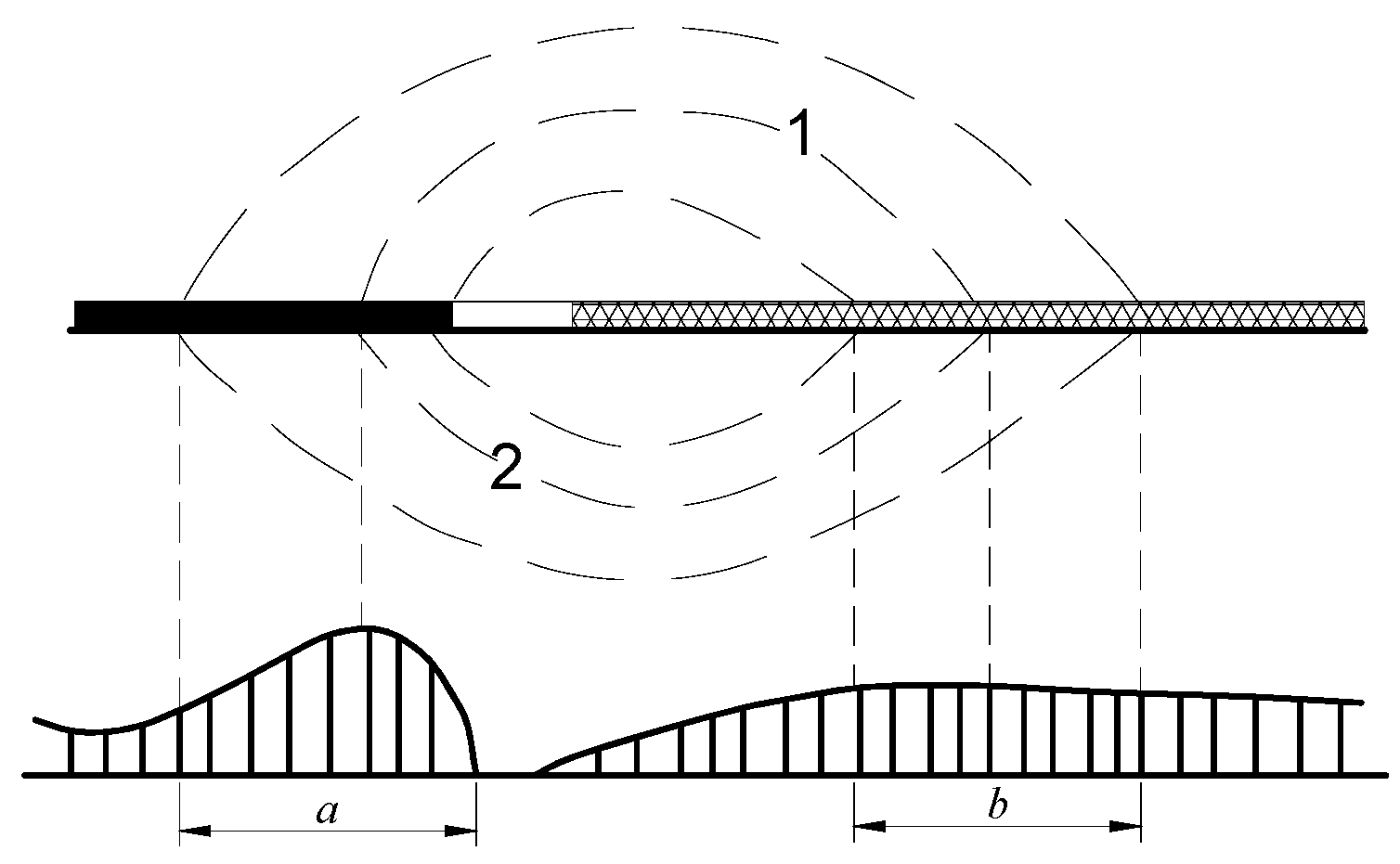
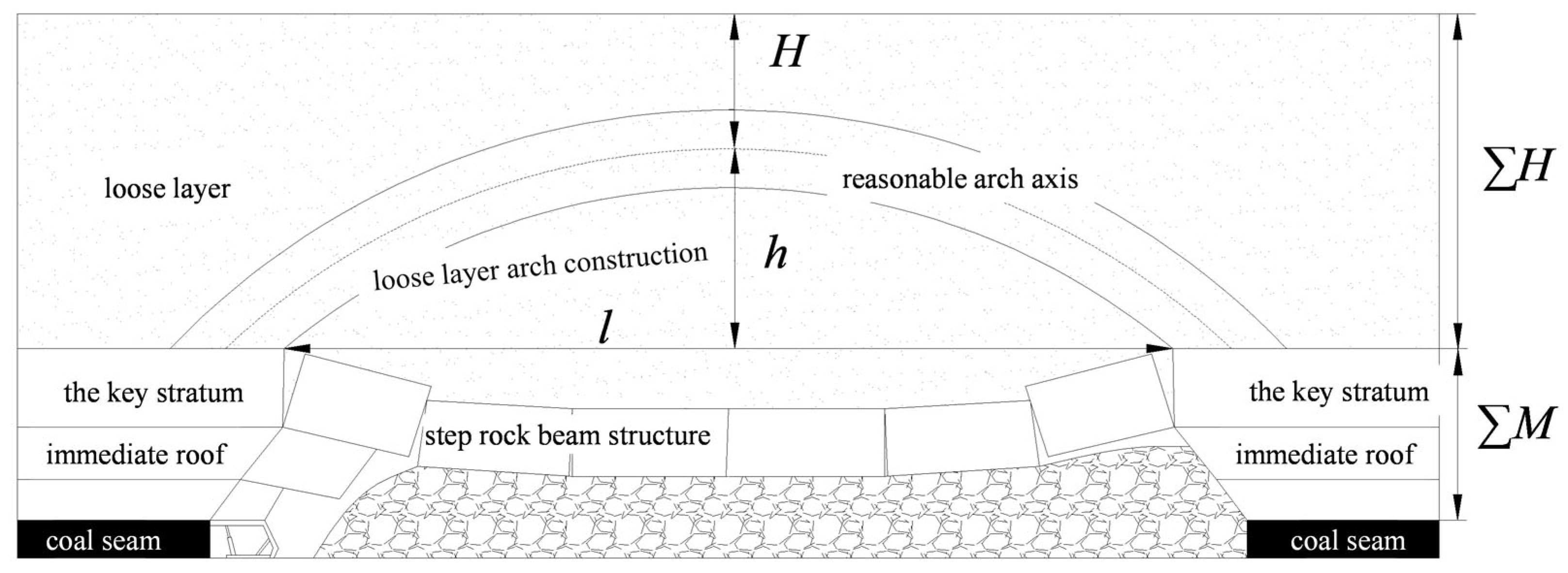
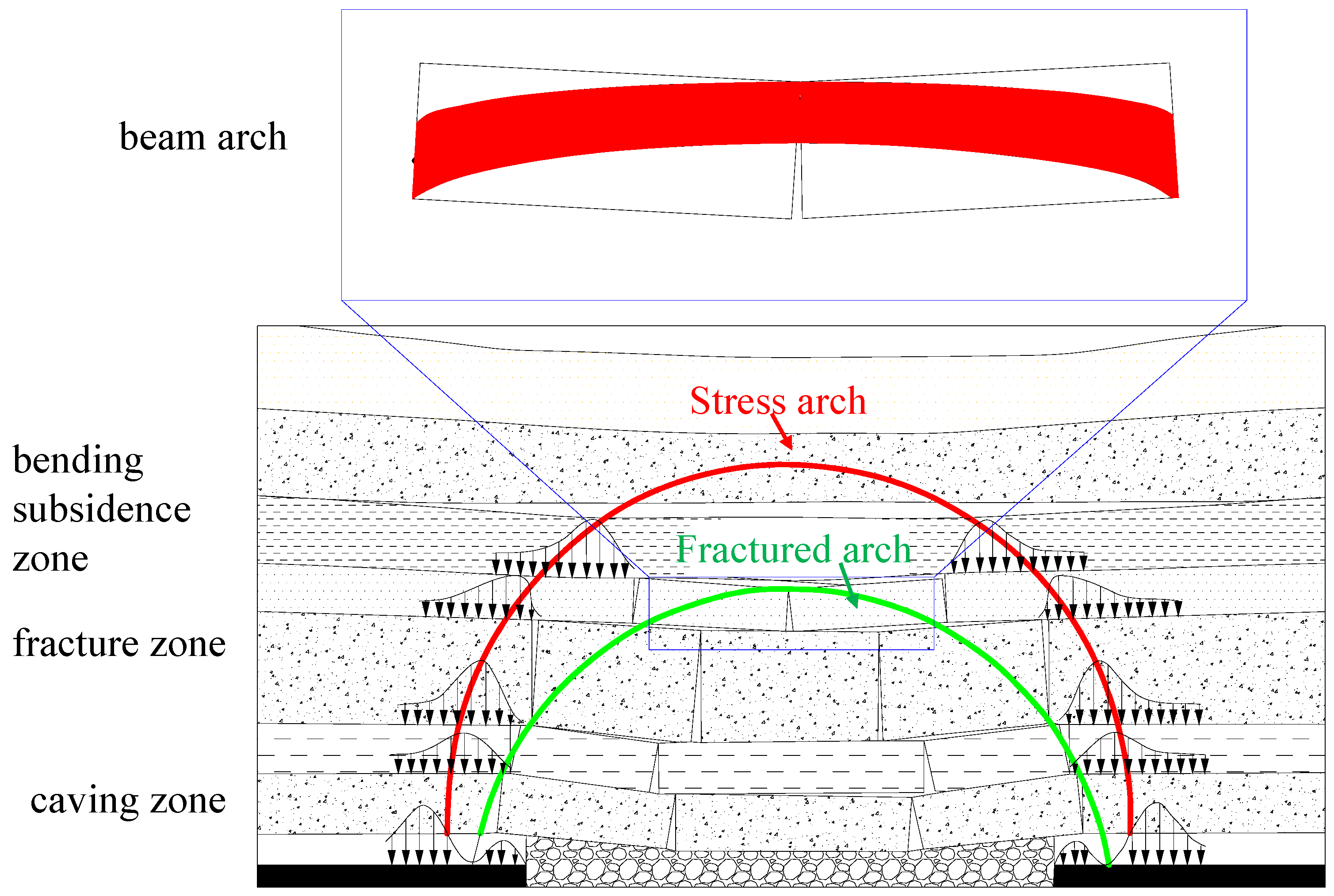
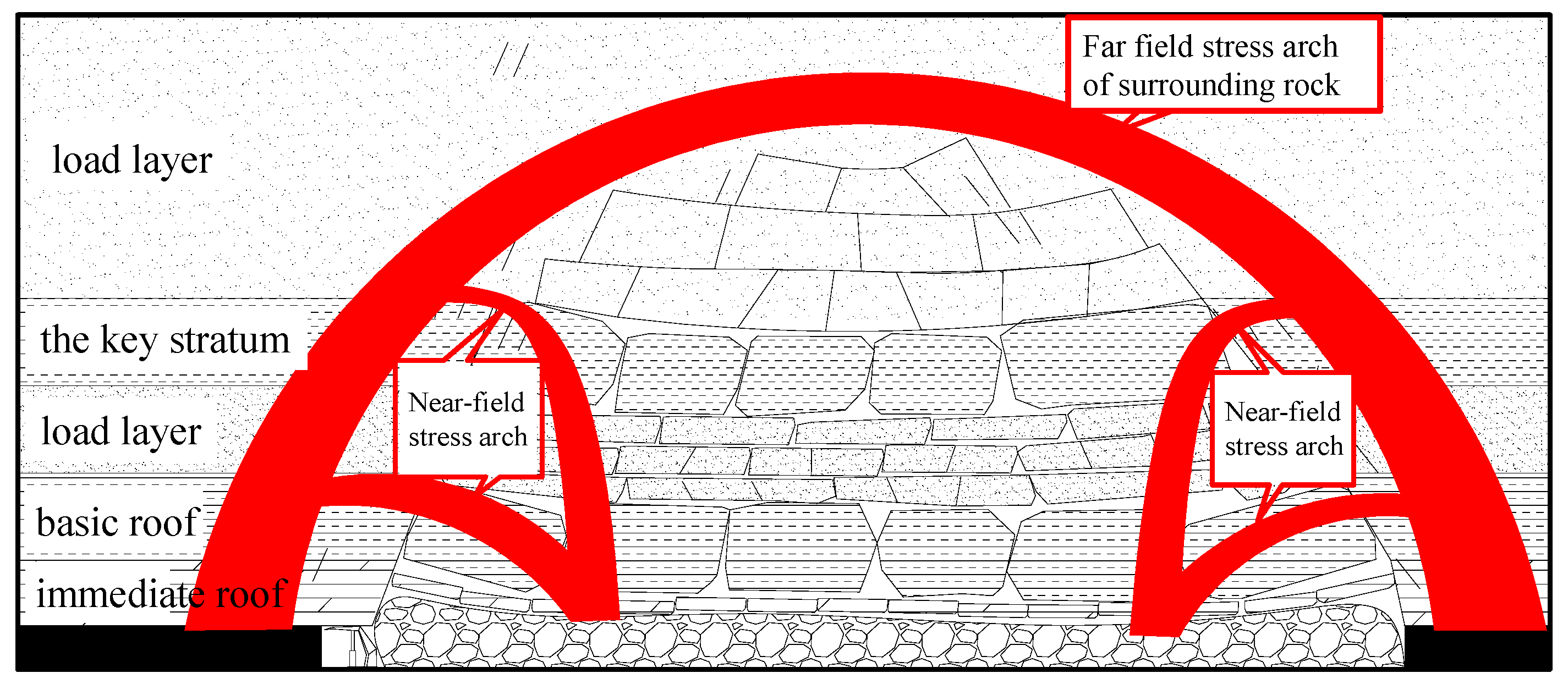
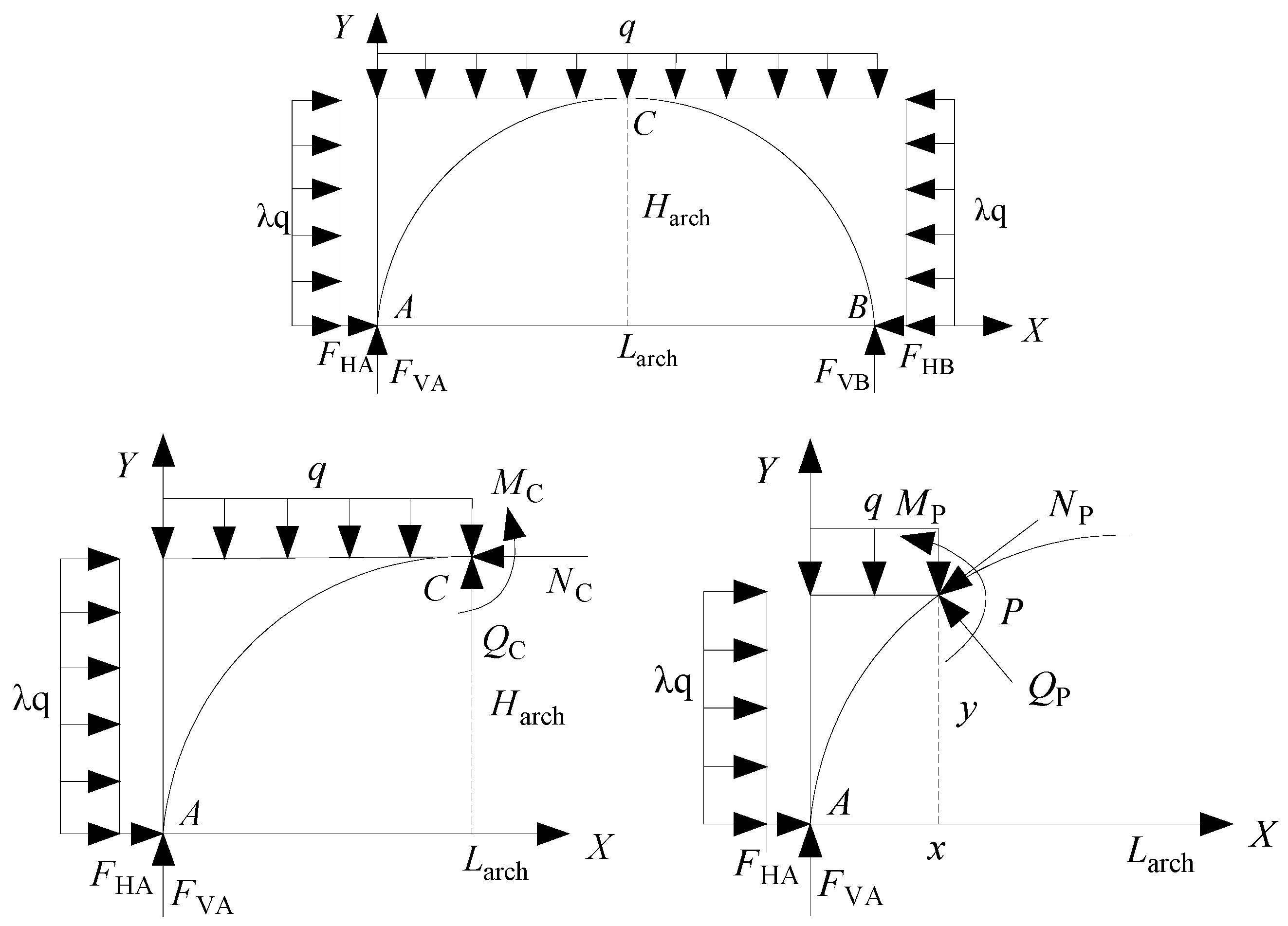




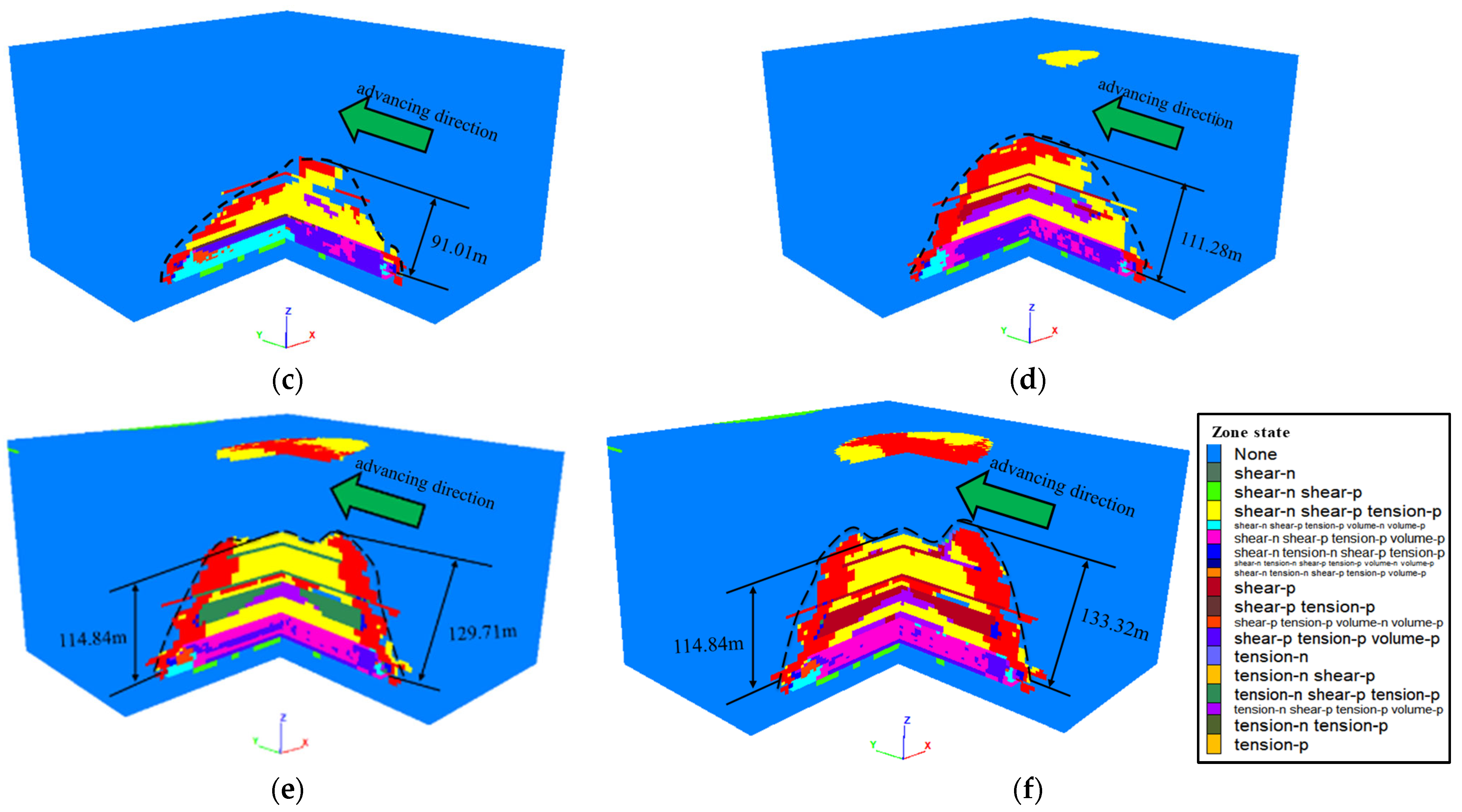

| Main Aspects | Specific Parameter Characteristics | Research Findings | |
|---|---|---|---|
| Arch structure characteristics | Arch forming condition | The arch forming condition of the unconsolidated layer arch is that the thickness of the unconsolidated layer is greater than the sum of the maximum rise height and thickness of the unconsolidated layer arch; The arching condition of the overburden fracture arch is that the overlying bedrock thickness of the working face is greater than the height of the fracture zone in the full mining stage; The arch forming condition of the overburden stress arch is sufficient horizontal stress; The arch forming condition of the beam arch is that a single, thick, hard rock layer can be broken to form an articulated structure | |
| Arch breaking condition | The instability modes of the arch: compression instability mode, tension instability mode, shear instability mode, and composite instability mode | ||
| Trace shape of arch | Arch trace mainly includes elliptic, semi-circular, parabolic, catenoid, hyperbolic function shape, etc. (3D ellipsoid or spherical). With the continuous advancing of the working face, arch shape evolves dynamically | ||
| Stress distribution of arch | The area where the arch axis is located is the stress increasing area; The outer part of the arch is the stress area of the original rock; The inner part of the arch is the pressure relief area | ||
| Arch thickness | In numerical simulation, it is considered to be the range of stress increasing area, while in theoretical model, it is mainly the arch foot thickness | ||
| Mining process parameters | Room and pillar mining method | The evolution characteristics of stress arch in room-and-pillar mining are similar to those in roadway surrounding rock | |
| Strip mining method | The strip mining stress arch is similar to the roadway stress arch, but the width of the separated coal pillar affects the independence of the adjacent strip stress arch | ||
| Longwall mining method | Fully mechanized top coal caving | The protective effect of stress arch formed by fully mechanized caving mining is greater than that of fully mechanized mining | |
| Filling mining | Compared with caving mining, the height of the arch structure is greatly reduced, and the shape of the arch is flat | ||
| Mining height | With the increase in mining height, the arch height increases | ||
| Length of working face | The stress concentration degree increases with the increase in working face length, the arch height increases gradually, and the flat rate increases | ||
| Advancing speed | The advancing speed can improve the bearing capacity of the arch | ||
| Width of coal pillar | The coal pillar width affects the superposition of the stress arch of two adjacent longwall working faces, and there is a critical coal pillar width. When the coal pillar width is larger than the critical coal pillar width, the stress arch of the two working faces are independent of each other | ||
| Geological conditions of rock stratum | Arching medium | The unconsolidated layer arch is formed under the condition of the thick unconsolidated layer. Single-layer thick hard rock formation beam arch; The overburden arch is mainly proposed for the whole overburden structure, and it can be divided into stress arch and fracture arch | |
| Lithology | The lithology is strengthened, the height of the stress arch is reduced and tilted, the bearing capacity of arch is enhanced, and the risk of dynamic disaster is enhanced | ||
| Dip angle | In the coal seam with high dip angle and sharp dip angle, the stress arch is symmetrical arch in strike and asymmetrical arch in dip angle | ||
| Burial depth | When the shallow coal seam is mined, the bearing capacity of the arch is lost after it extends to the surface. The arch structure will persist when the depth reaches a certain level | ||
| Application | Ground pressure prediction of working face | It can calculate the working resistance of hydraulic support and predict periodic weighting | |
| Roadway layout | Roadway layout inside the arch structure range | ||
| Prediction and control of surface subsidence | The subsidence range and maximum subsidence value can be calculated according to the fracture arch; The surface subsidence rate and fracture development pattern can be predicted according to the periodic instability of the unconsolidated layer arch | ||
| Roof aquifer control | Ensure that the maximum roof fracture arch height is below the aquifer | ||
| dynamic disaster control in coal mine | The instability of far-field stress arch is the main cause of rockburst, and the roof pre-fracturing should be carried out in the peak area of stress arch | ||
| Optimization of gas drainage technology | Gas extraction drilling holes should be arranged in the pressure relief area under the stress arch | ||
| Research focus | Theoretical research | Complicated stress boundary conditions, rock layer heterogeneity, irregularity of arch line, and the unequal thickness of the arch should be considered in the arch structure model | |
| Numerical simulation | Application of finite discrete elements or coupling of multiple simulation methods | ||
| Similar simulation | Update of stress monitoring methods | ||
| Field measurement | Overburden migration monitoring methods of space–sky–surface integration | ||
Publisher’s Note: MDPI stays neutral with regard to jurisdictional claims in published maps and institutional affiliations. |
© 2022 by the authors. Licensee MDPI, Basel, Switzerland. This article is an open access article distributed under the terms and conditions of the Creative Commons Attribution (CC BY) license (https://creativecommons.org/licenses/by/4.0/).
Share and Cite
Li, Q.; Guo, J.; Zhang, C.; Yang, Y.; Ma, J.; Ren, Z. Research Findings on the Application of the Arch Structure Model in Coal Mining, a Review. Sustainability 2022, 14, 14714. https://doi.org/10.3390/su142214714
Li Q, Guo J, Zhang C, Yang Y, Ma J, Ren Z. Research Findings on the Application of the Arch Structure Model in Coal Mining, a Review. Sustainability. 2022; 14(22):14714. https://doi.org/10.3390/su142214714
Chicago/Turabian StyleLi, Quansheng, Junting Guo, Cun Zhang, Yuliang Yang, Jianqi Ma, and Zhaopeng Ren. 2022. "Research Findings on the Application of the Arch Structure Model in Coal Mining, a Review" Sustainability 14, no. 22: 14714. https://doi.org/10.3390/su142214714
APA StyleLi, Q., Guo, J., Zhang, C., Yang, Y., Ma, J., & Ren, Z. (2022). Research Findings on the Application of the Arch Structure Model in Coal Mining, a Review. Sustainability, 14(22), 14714. https://doi.org/10.3390/su142214714






